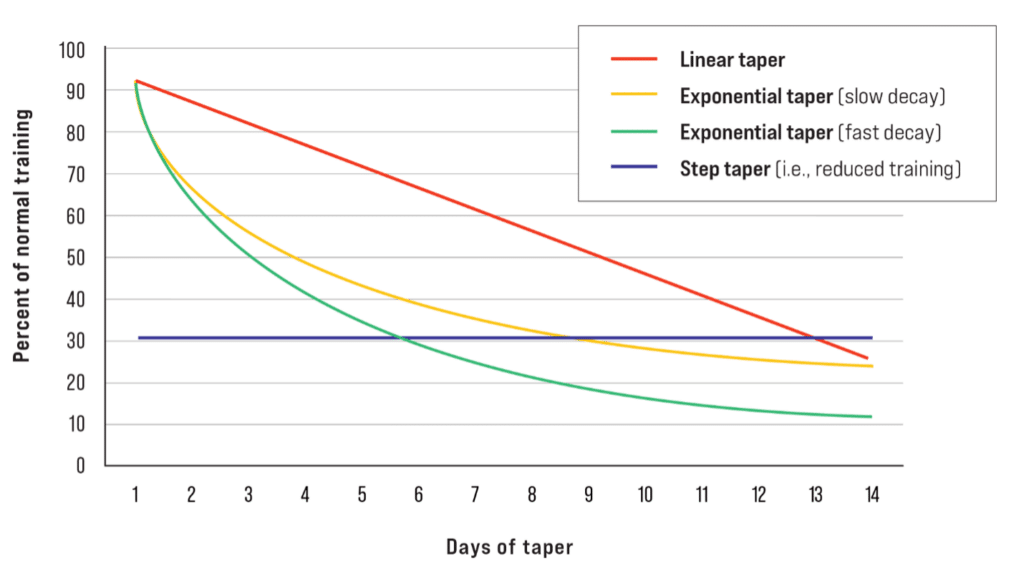
Tapering for Ultrarunning: How to Prevent Taper Tantrums
By Jason Koop,
CTS Head Ultrarunning Coach,
Author of “Training Essentials for Ultrarunning”
For many athletes, tapering for ultrarunning can be a double-edged sword. On the one hand runners are happy about the reduced training load. On the other, they are sometimes anxious or distressed by the reduction in training volume. Athletes have two primary fears during their taper: detraining and missing out on time they could use for additional training. These fears sometimes lead to a phenomenon we humorously refer to as “Taper Tantrums”. Avoiding taper tantrums just requires a bit of knowledge. By knowing the different strategies you can use and how much (or little) of a difference tapering can make, you can put yourself in a position to reap the greatest benefits.
Tapering Basics: Volume, Intensity, Frequency, Environment
Fundamentally, tapering is a reduction of training load. It’s not dissimilar from a normal recovery week or deloading phase, except that it immediately precedes a race. A boatload of research has been done on the subject, mostly in traditional endurance running events (like the 5k, 10k and marathon) and triathlon. Consequently, athletes and coaches tend to overcomplicate it and obsess over every detail.
Four Tapering Strategies
A cursory review of the literature reveals four different tapering strategies:
- Linear Taper: Reduces the amount of training load linearly throughout the tapering process.
- Step taper: Reduces the training load all at once (in one step, per se) and then maintains that load throughout the taper.
- Fast decay exponential taper and a Slow decay exponential taper. These are two flavors of the same concept. Both reduce training load more at the beginning of the taper and reduce the rate of decay over time. “Fast decay” features a more higher rate of reduction, meaning training load drops off more quickly and to a lower overall end point.
If you review the best literature on tapering, the research will recommend a “nonlinear, fast-decay reduction” of training load. Sounds like you need whip out your graphing calculator, right? It’s OK, I’ve done the work for you and created a visual representation of these four strategies in the chart below (just kidding, I adapted this chart from the foremost guru in the space Iñigo Mujika).
Although I love the ingenuity of this graph and the hours spent developing it, this level of minutiae is impractical. For example, in a “fast-decay” tapering process, on Day 5 daily training volume should be 32.5 percent of normal. If you were normally doing a two-hour run, this means your run for Day 5 should be 39 minutes. Not 40 or 38, but exactly 39. There’s nothing magical about 39 minutes of running on Day 5 of a taper or any other day. Athletes are human beings, not machines or lab rats. In my experience, it’s best to understand the science and then find ways to use it practically.

Figure 1- Schematic representation of the different types of tapers. Adapted from Mujika and Padilla 2003.
Now, with some perspective in hand, let’s look at the best overarching strategies for tapering based on the current literature. For calibration purposes, in this discussion, I’m assuming a three-week tapering process for a runner training 10 hours per week. Here’s what to do with training volume, intensity, frequency, and environment.
Volume: Reduce
Adjusting volume is your first step in the tapering process. Using a fast decay tapering model, volume should decrease very quickly at first and then level off toward the end. Thus, if you start with an overall volume of 10 hours per week, you should reduce that to four to five hours (40 to 50 percent of normal training volume) per week the first week. This should reduce to two to three hours (20 to 30 percent of normal training volume) the second week. In the last week, reduce to two hours maximum (<20 percent of normal training volume).
Intensity: Reduce the Amount, Not the Type
Intensity is where things get a little tricky. The overarching strategy is to reduce the volume of intensity during the week but not the type of intensity. The amount that you reduce the intensity should follow the “fast-decay” strategy. Similar to the way you reduce overall volume, you would reduce the volume of intensity quickly at first and then more slowly toward the end. For example, if you normally do four by 10-minute TempoRuns for a workout, during Taper Week 1 you would do three by five-minute TempoRuns (37.5 percent of the normal TempoRun volume). In Week 2 you would do two by five-minute TempoRuns (25 percent of the normal TempoRun volume). In the last week, one by five minutes (12.5 percent of the normal TempoRun volume).
Maintaining training intensity is a critical part of the tapering process. This is because including a small amount of intensity prevents a decline in the hard-earned benefits you worked for in training (Hickson et al. 1985; Sheply et al. 1992).
Frequency: Maintain or Slightly Reduce
Frequency should be maintained or slightly reduced. If you run five days per week, continue running five days per week. If you complete two specific workouts per week (TempoRun, SteadyStateRun, etc.), continue doing so. However, modify those two specific workouts per week using the guidelines above for reducing the volume of intensity. If you decide to reduce the frequency of training, only do so by one day per week.
Environment: Maintain
During your taper, maintain any terrain and vertical specificity you have been doing in training leading up to your race. In other words, if you have been running on trails, continue to run on trails. If you have been running on roads, run on roads. Here’s one mistake I see repeatedly. Athletes targeting mountainous trail events train on specific trails for those events, but then change that specificity during their taper. For instance, they run around the track in Chamonix in preparation for the Ultra-Trail du Mont-Blanc. This violates the final tapering strategy of maintaining terrain and vertical specificity.
How Much Does Tapering Improve Performance?
Although tapering is important, many athletes and coaches overestimate its effect on performance. Mujika and Padilla found that a properly constructed taper can improve performance by 3%. That’s significant, but keep in mind that means 3% compared to no taper at all. It might be a race-winning difference for an Olympic-level 10k, but at the ultramarathon distance, we don’t have to be nearly as precise.
I don’t stress too much over building the perfect taper because there isn’t much to be gained from perfection. A reasonable taper gets you most of the way there (1.5-2%), especially because the psychological aspect of tapering is so important. Stressing over it is counterproductive.
The Taper Tantrums
The previously mentioned strategies are primarily (but not exclusively) aimed at improving your physiological state before an event. Your psychological state is just as important. And although the tapering strategies presented here have been demonstrated to also improve psychological qualities (Hooper, Mackinnon, and Howard 1999; Morgan et al. 1987; Raglin et al. 1996), many athletes still struggle with this aspect of race preparation.
► Free Ultrarunning Training Assessment Quiz
Take our free 2-minute quiz to discover how effective your training is and get recommendations for how you can improve.
Athletes often believe they are losing fitness or missing out on training. The two to three weeks spent tapering seem to go on forever, and they doubt the process. They become antsy for the event, feel sluggish during their day-to-day life and runs, and become irritable and difficult to live with. This is normal, and it is important to understand that the “taper tantrums” are part of the process.
Angst and unease are normal psychological reactions to a taper. During the taper, you have more time and energy available than during your earlier training. That excess time and energy must go somewhere, and many athletes utilize it simply to fret. To release their energy, they pack and repack their luggage, obsessively analyze splits, and second-guess their choice of socks. Any rational person observing these actions from the outside would probably get a chuckle, but these athletes aren’t doing themselves any favors by expending their energy this way.
Minimizing Taper Tantrums
If tapering drives you mad, or you’re unfortunate enough to live with an ultrarunner during a taper, try the following:
- To better handle your taper, trust your training. If you have done the right things in training, the taper becomes easier to handle. Have confidence that the miles, vertical, and intensity you put in over the previous months will pay off. Even if your training was not perfect, if you have been conscientious and dedicated to the process, you should trust that you have done enough.
- Create the right mindset for tapering. I routinely ask athletes to review their training just in advance of their taper. Specifically, I have them look at the sheer quantity of time they have dedicated to the process. The enormity of what they have done over the last several months (which numbers in the hundreds of hours) puts the last few workouts in perspective (which is normally tens of hours). Those last workouts account for a very, very small part of the entire process.
Avoid the taper tantrums by trusting your training and the tapering process. If you trust that you are going to come out the other side of a taper refreshed and ready for the event, the time you spend not running suddenly has purpose.
This is an excellent time to put your excess energy into rest. Yes, this takes just as much focus and energy as training, maybe even more so for ultrarunners. Load up on your favorite Netflix series or take the time to catch up on some reading. In any case, take the time you previously set aside for training and deliberately, intentionally set it aside for purposeful rest.
Quick Review: Tapering Guidelines for Ultrarunning
Intensity and specificity are of the biggest keys to a successful taper. Athletes often make the mistake of reducing both volume and intensity. They simply do less overall. Although that can be better than overdoing it, the goal should be to reduce training volume and volume-of-intensity, but not the actual intensity of the intervals you do. Here’s what to do:
Enjoying This Article? Get More Free Running Training Tips
Get our coaches' best training advice, delivered straight to your inbox weekly.
- Before you taper, train: No amount of tapering will make up bring undertrained. Seriously, don’t blame your taper for a bad race. It matters very little in comparison to the entirety of training.
- Begin taper 2-3 weeks prior to a goal event. You can individualize this timeframe based on previous experience.
- Lessen training load quickly at first, then gradually as the race approaches.
- Reduce overall volume (shorten runs first, then reduce frequency if necessary)
- Reduce amount of intensity (minutes or number of intervals)
- Maintain intensity level (go just as hard, just not as long)
- Maintain terrain and vertical specificity (you’re still preparing for a running race…)
One Final Warning
Some athletes start incorporating new and novel activities during their taper, which is an odd time to add something new. Many times, the intent is to optimize recovery or squeak out another marginal improvement. But you’ve already done 98% of your training; you have the fitness you’re going to have for race day. The best thing you can do during a taper is to stay specific to the terrain, grades, and surfaces you’re going to race on. Simplify, don’t add.
References
Hooper, Sue L., Laurel T. Mackinnon, and Alf Howard. 1999. “Physiological and Psychometric Variables for Monitoring Recovery During Tapering for Major Competition.” Medicine and Science in Sports and Exercise 31 (8): 1205–1210.
Morgan, W. P., D. R. Brown, J. S. Raglin, P. J. O’Connor, and K. A. Ellickson. 1987. “Psychological Monitoring of Overtraining and Staleness.” British Journal of Sports Medicine 21 (3): 107–114.
Mujika, Iñigo, and Sabino Padilla. 2003. “Scientific Bases for Precompetition Tapering Strategies.” Medicine and Science in Sports and Exercise 35 (7): 1182–1187.
Raglin, John S., David M. Koceja, Joel M. Stager, and Craig A. Harms. 1996. “Mood, Neuromuscular Function, and Performance During Training in Female Swimmers.” Medicine and Science in Sports and Exercise 28 (3): 372–377.


Comments 12
I’m in the second week of taper. I did 70 or 12 hours at peak. At 30% I should run 21 miles this week. I run six days a week. So that’s 3.5 miles a day. That doesn’t seem like nearly enough miles to run in week two before a race. I’m reading the book and have followed it since Jan and feeling maybe I’m missing something.
As I’ve grown older (now 66) I’ve changed my training considerably in order to keep myself in the game. I’ve done this by reducing mileage volume and workout intensity while incorporating more power-walking into my workouts which has resulted in a reduction of injuries while still challenging me competitively and achieving race goals. On a flat 100M course, I’m still able to run sub-24 hours. I’ve changed my taper from 2 weeks to 3 weeks for 100M+ ultras while reducing mileage volume by 25% in each of the first two weeks and 30% in the final week before a race. I don’t decrease intensity and rarely if ever do intervals as part of my normal training. I do keep to the same terrain that I have been running throughout my training. The final week before a race, my focus is strictly on rest and recovery with my runs being maintenance miles. I’ve developed this approach on my own so I don’t really know if it’s the best for me. Though I have been pleasantly surprised at being able to still run ultras while being competitive in my age group and achieving most of my race goals. I’m always interested in learning new things, so please feel free to respond if you like. Thanks for these articles, they’re very informative.
Pingback: How CTS Coaches Prepare Athletes for the Unique Demands of Western States - CTS
Pingback: Everything to Know About Tapering for a Marathon – Michael Capiraso
Pingback: Half Marathon Taper: How to Master Recovery & Performance
Shouldn’t reducing during week #2 either be; 75% of normal, or 25% of week #3?
Pingback: The Benefits Of Tapering Before A Half Marathon | Nautica Malibutri
For the last 3 years I have been bothered by ITBS during ultras, including onset at mileage that is less than regular training runs. While I primarily blame travel, I’ve been curious about the role tapering might play. It’s tempting to stretch more during tapering, but I’m nervous about violating the ‘nothing new’ principle.
Is massage during a taper week a bad idea?
Great article ! Thank you:)
Pingback: Ultramarathon Daily News | Fri, June 10 - Ultrarunnerpodcast.com
Pingback: Jason Koop's Ultrarunning Training Presentation from 2017 Western States Endurance Run - CTS
Pingback: Ultramarathon and Trail Running Daily News | Thursday, June 22